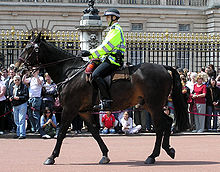Flour mouth



A characteristic head color in solipeds is called the flour mouth . With this coat color, the snout area is clearly contrasted with the rest of the coat color.
In a broader sense, the word is often used for any lightening in the snout area.
Appearance
The gene that causes the flour mouth leads to a white mouth, lightened belly and light insides on the legs in horses.
Flour mouth as a characteristic of wild horses
To what extent the flour mouth is a characteristic coat color in the Przewalski horse is controversial. The world population of this wild horse breed goes back exclusively to twelve wild-caught horses . Recordings from the end of the 19th and beginning of the 20th century, when these horses were first caught, also showed wild horses in which no flour mouth is recognizable.
Races
ass
A meal of meal is common in donkeys .
Horses
The flour mouth appears particularly frequently in horse breeds that are still very close to the wild horse and in which there are also duns. Breeds that often have a flour mouth are for example the Norwegian fjord horse , the Haflinger , the Dülmen wild horse , the Dartmoor pony and the Exmoor pony .
genetics
The gene pangare , sometimes also referred to as mealy, is represented by P or Pa. The gene is particularly widespread in many pony breeds and in the Przewalski horse. Horses that carry the gene have a meal of flour, light hair around the eyes, a light belly, and light inside legs. The flanks can also be slightly brightened.
The gene only brightens the brown color and does not affect black.
The exact location of the gene is unknown, but it has been suggested that the pangare gene is identical to the flaxen gene, which turns a fox into a light fox . This is obvious, since foxes with a dark mane but with a flour mouth obviously do not appear. Since there is currently no genetic test for both genes and therefore it is neither certain that there is only one Mealy or Flaxen gene nor whether one or more of these Flaxen genes is identical to a Pangare gene, this theory has so far neither been conclusively refuted nor certainly occupied.
Possibility of confusion
The color of black-brown , which is called "Seal Brown" in English , is not caused by this gene . They are almost black horses that are brown in the areas that would be colored from brown to white by the meal-mouth gene pangare, while they are black in the areas that would not be influenced by the meal-mouth gene. However, a mutation of the agouti locus is responsible for this variant .
See also
swell
- D. Ph. Sponenberg: Equine Color Genetics. 2nd Edition. Blackwell Publishers, 2003, ISBN 0-8138-0759-X .
